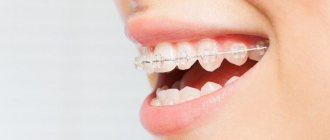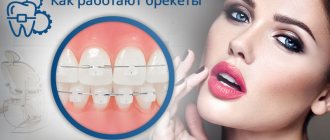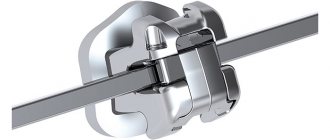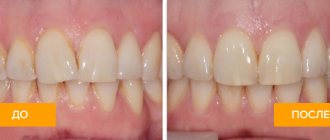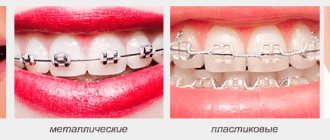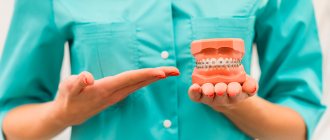What are self-ligating braces?
The operating principle of a non-ligature construction is easiest to understand if you compare it with a ligature construction.
Classic ligature braces: clasps are fixed on the surface of each tooth and connected to each other by an orthodontic arch. The clasps and arch are attached to each other with fasteners - ligatures. They can be special rubber bands or wires. These elements gradually move the teeth and bite into the position specified by the orthodontist. This happens due to the teeth overcoming the frictional force. The disadvantage of ligatures is that during the treatment they need to be changed frequently, as they stretch, cease to perform their function, plus they lose their original aesthetic appearance - they change color.
To make orthodontic treatment more comfortable for the patient, manufacturers of dental corrective structures have developed braces without ligatures. They differ from classic ligature ones in the way the clasps and arches are connected: the latches in them are replaced with special latched covers built directly into the clasps themselves. It turns out that the locks seem to be strung on an arc, and not attached to it with “clothespins”.
During treatment with ligature-free braces, the frequency of visits to the dentist is reduced: the fixing elements in them do not fail, so the structure needs to be adjusted much less frequently.
Self-adjusting braces
Classic braces systems are fairly voluminous structures that provide gradual displacement of teeth in the required direction due to an arch firmly attached to the braces using elastic ligatures - rubber bands. But most patients are embarrassed by the lack of aesthetics of such systems, the discomfort that occurs when such a brace system is overloaded, as well as other difficulties that arise during dental care. Specialists in the field of aesthetic dentistry, creating new types of tools for straightening the bite, tried to take these points into account as much as possible, and thus self-adjusting braces came into the arsenal of orthodontists, differing from conventional ones in the absence of any additional mechanisms.
Such braces do not require conventional ligatures. The already outdated rubber bands have been replaced by reliable latches. At the same time, an overdose of forces is almost completely eliminated, since when overloaded, the clip seems to release the arc, allowing it to move without problems like sliding doors. This also allows you to correct your bite and significantly reduce treatment time. In addition, there is no need for regular visits to the orthodontist’s office, since there is no need to change an elastic ligature that is broken/damaged during use. Self-adjusting braces are examined by an orthodontist once every couple of months - this is enough for safe and correct treatment.
MAIN ADVANTAGES OF SELF-REGULATING BRACKET SYSTEMS
A distinctive advantage of braces is the use of small physiological forces. According to reputable doctors and other specialized specialists, this approach makes it possible to significantly reduce the trauma of the entire process of occlusion correction and can reduce treatment time by 25%.
Some self-ligating braces allow for more individualized correction, as it is possible to program the bracket system for how each tooth should be positioned. This makes the process of moving teeth much more predictable, and the result optimal.
A huge variety of such brace systems makes it possible to choose exactly the one that is best suited in each individual case. For people who value maximum functionality rather than aesthetics, orthodontists recommend durable self-ligating metal braces. And ceramic bracket systems are perfect for people who are accustomed to giving preference to aesthetics. However, there are also compromises: the same non-ligature braces, which ideally combine the strength of steel and the aesthetics of ceramics.
ADVANTAGES OF USING NON-LIGATION BRACKET SYSTEMS
- Self-adjusting braces do not have hooks and take up very little space in the mouth. This significantly reduces adaptation time and makes oral care easier.
- Also, ligature-free braces are the only method of teeth straightening that can be offered by a doctor to a patient with periodontal disease.
- During the installation of self-ligating braces, the patient can avoid wasting his time and come for an appointment once every 3 months.
- The arc change time, thanks to the clamps, takes 10-15 minutes.
- Well, the main difference between self-ligating braces and ligature braces is that teeth are straightened with the help of the muscles of the tongue, cheeks and lips, and a positive result is achieved faster and lasts for a long time.
- Ligature-free braces apply little pressure on the oral mucosa, resulting in a reduction in trauma to almost zero.
- To successfully continue treatment, it is enough to rarely visit the doctor once every 2-3 months.
- They are made from proven and pure materials that do not interact with the environment in the oral cavity.
- The absence of ligatures in such brace systems greatly simplifies oral care for patients.
- Patients wearing such braces quickly get used to them due to their optimal size.
- When correcting your bite, you will not have to remove teeth.
- The alignment process is calculated for all teeth separately.
- Their design guarantees continuous operation of the archwire, which is why you do not have to go to a specialist to activate your braces. This is very important for patients who do not have enough time to visit the dentist.
- Self-ligating braces have a pleasant appearance.
- Removal and installation of the structure takes place as quickly as possible.
DISADVANTAGES OF SELF-REGULATING BRACKET SYSTEMS
Ligature-free braces have one single drawback: they are incredibly expensive compared to conventional braces. The high cost is explained by the complexity of the working mechanism of non-ligature bracket systems. In addition, due to their great complexity, ligature-free braces cannot be installed everywhere.
TYPES OF NON-LIGATION BRACKET SYSTEMS
Ligature-free braces can also be made of ceramic or metal, just like regular braces. This affects the course of treatment and its price.
METAL SELF-REGULATING BRACKETS
Non-ligature metal braces are the most popular and common type of non-ligature braces. Such metal braces have long proven their effectiveness and cope well even with complex cases. They are used in the correction process even in the most difficult cases.
BEST MANUFACTURERS OF LIGATE-FREE METAL BRACKET SYSTEMS
- Damon Q. These braces are used if the clinical case is difficult to treat. The system can be configured separately for each person. Moreover, the doctor himself can predict the treatment, and the Damon Q brace system will work in such a way that the result will be obtained in the shortest possible time.
- Damon 3MX. For a long time, this system was considered one of the most advanced non-ligature brace systems. The main advantage of Damon 3MX is that they do not have cutting corners and are thin, which ensures the greatest comfort and addiction;
- Smart Clip. These ligature-free braces have a unique patented official snap mechanism. This mechanism makes it possible to accurately control the arc strength and, if necessary, change it to provide the best effect during the treatment process;
- In-ovation R. This bracket system has a very small size, which allows it to install an arch of almost any size on the brackets. Among other things, the unique design allows you to act on the arch, additionally reducing the time of orthodontic treatment.
Wearing ligature and non-ligature braces: what is the difference?
Both types of structures effectively perform their task - correct the pathology of teeth closure, return teeth to the anatomically correct position. But for the patient, the process of wearing them will be different.
- Non-ligature designs look neater, “lighter”, more inconspicuous: they have no additional elements, and the clasps themselves are smaller.
- Caring for self-ligating systems is much easier: metal and rubber ligatures often contain food fragments and need to be cleaned more thoroughly and for longer.
- The main difference we have already mentioned is the frequency of correction. When wearing classic ligature braces, you need to visit the orthodontist every three to four weeks, and when wearing non-ligature braces - every six to eight weeks. For many patients, this is a decisive moment when choosing an orthodontic system.
Photos of treatment stages on self-ligating braces
MAIN ADVANTAGES OF SELF-REGULATING BRACKET SYSTEMS
A distinctive advantage of braces is the use of small physiological forces. According to reputable doctors and other specialized specialists, this approach makes it possible to significantly reduce the trauma of the entire process of occlusion correction and can reduce treatment time by 25%.
Some self-ligating braces allow for more individualized correction, as it is possible to program the bracket system for how each tooth should be positioned. This makes the process of moving teeth much more predictable, and the result optimal.
A huge variety of such brace systems makes it possible to choose exactly the one that is best suited in each individual case. For people who value maximum functionality rather than aesthetics, orthodontists recommend durable self-ligating metal braces. And ceramic bracket systems are perfect for people who are accustomed to giving preference to aesthetics. However, there are also compromises: the same non-ligature braces, which ideally combine the strength of steel and the aesthetics of ceramics.
ADVANTAGES OF USING NON-LIGATION BRACKET SYSTEMS
- Self-adjusting braces do not have hooks and take up very little space in the mouth. This significantly reduces adaptation time and makes oral care easier.
- Also, ligature-free braces are the only method of teeth straightening that can be offered by a doctor to a patient with periodontal disease.
- During the installation of self-ligating braces, the patient can avoid wasting his time and come for an appointment once every 3 months.
- The arc change time, thanks to the clamps, takes 10-15 minutes.
- Well, the main difference between self-ligating braces and ligature braces is that teeth are straightened with the help of the muscles of the tongue, cheeks and lips, and a positive result is achieved faster and lasts for a long time.
- Ligature-free braces apply little pressure on the oral mucosa, resulting in a reduction in trauma to almost zero.
- To successfully continue treatment, it is enough to rarely visit the doctor once every 2-3 months.
- They are made from proven and pure materials that do not interact with the environment in the oral cavity.
- The absence of ligatures in such brace systems greatly simplifies oral care for patients.
- Patients wearing such braces quickly get used to them due to their optimal size.
- When correcting your bite, you will not have to remove teeth.
- The alignment process is calculated for all teeth separately.
- Their design guarantees continuous operation of the archwire, which is why you do not have to go to a specialist to activate your braces. This is very important for patients who do not have enough time to visit the dentist.
- Self-ligating braces have a pleasant appearance.
- Removal and installation of the structure takes place as quickly as possible.
What materials are ligature-free braces made from?
Locks for self-ligating structures are made from the same materials as for classic ligature braces - metal, ceramics and artificial sapphires.
Metal self-ligating braces
They are the easiest to install and remove. These durable, reliable systems correct all malocclusion pathologies and effectively move teeth into the desired position. Cheaper than designs made from other materials, therefore popular with patients.
Self-ligating ceramic braces
They are made from durable white dental ceramics in different shades, so they look more attractive than metal ones. The clasps of such systems are invisible, since the ceramics merge with the tooth enamel. The only noticeable detail is the orthodontic arch. They have one drawback - fragility compared to structures made from other materials.
Sapphire self-ligating braces
Like ceramic ones, they are almost invisible on the teeth. They are, of course, not made from natural sapphires - otherwise their price would be very high. During production, a transparent artificial material is used, the characteristics of which are identical to sapphires. They reflect light and make your smile really sparkle. Sapphire braces are more often used in the treatment of complex malocclusion pathologies; they are stronger than ceramic ones.
Peculiarities
This design completely eliminates ligatures. They have been replaced by convenient locks with an automatic latch, which ensure free movement of the arc in the grooves.
Thanks to innovative technology, the patient no longer needs frequent visits to the dental clinic to correct the pressure exerted by the arc. The pressure on the dentition now changes without medical intervention. There is no need to change the ligatures, so visits to the doctor can be reduced to once every three months.
Key Benefits
Since little physical force is used during the treatment, adaptation is less painful and the patient feels as comfortable as possible. Also, ligature-free braces models guarantee less trauma and faster achievement of your goals.
Certain types of systems make it possible to correct the bite according to a pre-programmed scenario, that is, the treatment becomes more individual. This technology allows you to set the desired position of each tooth and predict the outcome of treatment as much as possible.
For those patients for whom the aesthetic side of the issue is not so important and who want to save on treatment, professionals recommend metal structures. They are the most effective and guarantee optimal results within 1.5 to 2 years.
Those people who are worried about their attractiveness and communicate a lot with others can be advised to wear braces made of ceramic or artificial sapphire.
Key advantages of self-regulating braces systems:
- They are smaller in size due to the lack of special hooks. This makes the habituation process faster and maintenance simpler.
- Suitable for patients with periodontal diseases.
- Rare visits to the clinic for examination and correction. Saving.
- The arc can be replaced in the shortest possible time period; it does not take more than 15 minutes.
- The effect is noticeable faster due to the fact that the muscles of the cheeks, lips and tongue are additionally involved in straightening the teeth.
- The result obtained lasts for a long time.
- Less trauma while wearing the system due to the lack of friction of the elements against soft tissue.
- Braces are made from hypoallergenic materials.
- Brushing your teeth becomes much easier.
- Dismantling the structure is quick and painless.
Minuses
Unfortunately, non-ligature braces have one single drawback - the rather high cost of manufacturing and installation. This is easy to explain, since the design itself is more complex, and not every doctor has sufficient qualifications to install it. That is why you should not believe numerous advertisements that promise excellent results for less money. Never save on your health, because it is better to overpay a little, but at the same time be sure of an impeccable result. Only a true professional will conduct a detailed consultation, tell you about all the nuances of the upcoming treatment, risks and guarantees. Having a complete understanding of the installation process and further restoration, you will be more loyal to the high cost of the technician’s work.
Aesthetic system without ligatures - what is it?
It is widely believed that non-ligature braces are a type of aesthetic system. In fact, this is only partly true.
Aesthetic self-ligating braces include ceramic and sapphire designs. Metal ones, although they look more attractive than ligature systems due to small locks, can hardly be called aesthetic. They look neat, but are much more noticeable than designs made of ceramics and artificial sapphires.
Also, aesthetic non-ligature braces include lingual systems - they are attached to the “lingual”, inner surface of the teeth. Such designs are invisible and are often chosen by public people.
The only drawback of non-ligature aesthetic systems is their high price. In order to reduce it, dentists combine materials: in the frontal zone, sapphire or ceramic clasps are fixed on the upper teeth, and metal ones on the lower jaw, chewing teeth.
Main brands of self-ligating non-ligating braces
Popular brands of non-ligation systems include Damon, Clarity, Experience, In Ovation, H4.
Damon.
Perhaps the most famous brand of braces without ligatures. Its product line includes designs to solve any problems with bite and misalignment of teeth. The main advantage of these American systems is the damper mount developed by the company. It simplifies the archwire replacement process and reduces correction time.
Experience.
Japanese non-ligature designs, characterized by the small size of the clasps and their structure. Each clasp fits very tightly to the tooth enamel. Plus Experience controls the movement of each tooth.
Clarity SL.
Damon's main competitors. They are made of ceramic, but the groove in their clasps is made of stainless steel. This guarantees smooth sliding of the arc, as in metal systems. At the same time, they are classified as aesthetic systems, since they are invisible on the teeth. Treatment duration with Clarity SL is typically reduced by 25%. However, it all depends on the clinical picture.
In Ovation C.
These are ceramic non-ligature structures from the American company DENTSPLY. These systems are designed to prevent incorrect fixation. In Ovation C clasps are 100% protected from discoloration during wear - for this, the manufacturer coated them with a layer of zirconium dioxide.
H4.
Another self-ligating braces made in America. They are distinguished by a low profile of the locks and a minimum size of the groove for the orthodontic arch. Allows better control of treatment at the final stage.
Differences between self-ligating and ligature bracket systems
The ligature bracket system, in addition to the metal arch and plates, includes an important connecting element - ligatures. Ligatures can be made of metal or rubber. They fix the orthodontic arch, affecting the movement of dental units. The design of the ligature system consists of a lock, an arc and a ligature. The main disadvantage of such equipment is the rapid wear of the ligature from mechanical stress, and, as a result, its frequent replacement. If you neglect this, then the entire course of correction at the orthodontist will not bring the desired result.
To correct the lack of ligature systems, non-ligature self-ligating braces were invented, which make it possible to correct the position of dental units and occlusion pathologies faster and more comfortably. In terms of the components in braces, ligature and non-ligature, the difference is that instead of ligatures, specialized latches are used to fix the arc in the groove of the plate. Such locks, unlike ligatures, do not change under mechanical influence, do not need to be replaced, and create minimal impact on the teeth. All this makes it possible to carry out treatment using ligature-free braces comfortably and with a small number of visits to a specialist to set up the equipment. Both devices in orthodontics effectively correct the bite and position of the teeth. However, the self-ligating bracket system has great advantages.
As an alternative to treatment with metal plates, Implantmaster orthodontists can offer transparent aligners for aligning the position of teeth. They are removed for periods of eating and brushing teeth. Doctors scan jaws using 3Shape Trios (instead of casts) and perform 3D modeling of each stage of tooth movement, visualizing the entire process of improving a smile.
How are ligature-free systems installed?
The process of fixing self-ligating non-ligature structures is no different from installing classical ligature systems.
- Before fixing the structure, a full examination of the oral cavity is carried out; sometimes, to achieve the desired result of orthodontic treatment, teeth are removed and dentures are installed. All carious lesions must be removed and professional cleaning carried out.
- Locks of the chosen design are fixed to the teeth. This happens with the help of dental glue. This is the most critical stage: incorrectly installed locks will negatively affect the duration and quality of treatment.
- If necessary, the remaining glue is removed, and the clasps are finally secured to the teeth using a lamp with ultraviolet light.
- On the side, on the chewing teeth, orthodontic rings and locks are fixed.
- All installed locks are connected to each other by means of an orthodontic arch, which is fixed in their grooves.
Installation of the system takes about one hour. But the preparatory stage may well last for several weeks or even months - it all depends on the initial condition of the patient’s oral cavity.
Cost of self-ligating braces at Implantmaster
Consultation with an orthodontist
- X-ray panoramic image
- Oral examination
- Drawing up a treatment plan with costs
Price : 2,000 ₽
*if treatment continues in the clinic according to the plan, the consultation is not paid
| Self-ligating metal braces Damon Q | from 250,000 ₽ |
| Self-ligating ceramic braces Damon Clear | from 250,000 ₽ |
| Aligners - trays for straightening teeth | from 350,000 ₽ |
Which braces to choose - with or without ligatures?
Non-ligature braces look more aesthetically pleasing than classic ligature braces, reduce the number of visits to the orthodontist, correct the bite faster, move teeth more gently, and can be used for periodontal diseases. Thanks to the design of self-ligating systems, the process of their correction takes fifteen to twenty minutes. In addition, the absence of ligatures protects against pain that can occur if the orthodontist “tightens” the ligature.
The disadvantage of self-ligating structures is their high price. Apparently, for this reason, classic ligature systems are still very popular. They are especially often chosen by teenagers and young people, who, in addition to saving money, receive another bonus - the opportunity to experiment with the color of the ligatures, making their braces unique, emphasizing their individuality.
In general, when choosing an orthodontic system, doctors and patients are guided by two principles - the ability to effectively get rid of malocclusion pathology and the ability to pay for treatment. Both ligature and non-ligature constructions allow you to achieve the desired result.
Types of self-ligating braces, how they differ
In our clinic, orthodontic treatment is carried out with non-ligated braces ]Forestadent[/anchor] and ORMCO (Damon). These are comfortable, aesthetic and effective devices that allow you to achieve results as quickly as possible.
Metal
Inexpensive corrective devices that cope with even the most complex malocclusions. They are made of medical steel, do not break, and do not require complex care. If the lock comes off, you can glue it back on. The main disadvantage of metal systems is unsatisfactory aesthetics, however, manufacturers offer improved models with small locks with rounded corners.
Ceramic
Aesthetic, matched to the color of tooth enamel, practically invisible. However, treatment with such devices takes longer than with metal ones. Patients should take into account that due to active chewing loads, chips are possible. Ceramic braces are used in patients for whom the aesthetic side is extremely important during the orthodontic course.
Sapphire
The most invisible, due to the high degree of transparency of the material (artificial sapphire). They retain their original properties throughout the course of treatment and are not stained by food coloring. Among the disadvantages of sapphire braces: high price.
Combined
Combined braces are used when it is necessary to combine aesthetics and functionality. Braces made of different materials are installed in different parts of the jaw. For example, in the smile zone there are ceramic ones, and in the side ones there are metal ones. Combination allows you to save on treatment, while achieving results and at the same time maintaining aesthetics.
